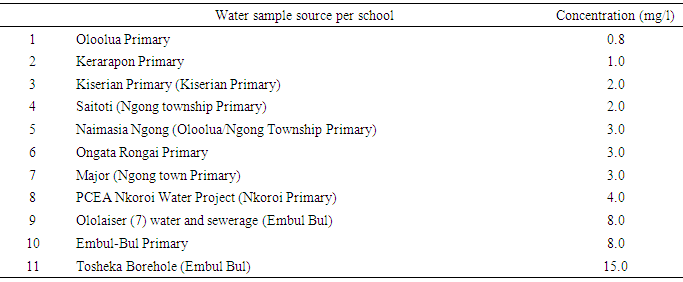-
Paper Information
- Next Paper
- Previous Paper
- Paper Submission
-
Journal Information
- About This Journal
- Editorial Board
- Current Issue
- Archive
- Author Guidelines
- Contact Us
American Journal of Medicine and Medical Sciences
p-ISSN: 2165-901X e-ISSN: 2165-9036
2018; 8(1): 295-311
doi:10.5923/j.ajmms.20180811.02

The Intellectual Efficiency of Adolescents Aged 13-15- Years-Old Using Drinking Water with Varying Fluoride Concentrations in Kajiado North Sub County, Kajiado County
Benjamin Induswe1, Gladys Opinya1, Lincoln Imbugwa Khasakhala2, Richard Owino1
1Department of Paediatric Dentistry & Orthodontics, School of Dental Sciences, University of Nairobi, Kenya
2Department of Psychiatry, School of Medicine, University of Nairobi, Kenya
Correspondence to: Gladys Opinya, Department of Paediatric Dentistry & Orthodontics, School of Dental Sciences, University of Nairobi, Kenya.
| Email: |  |
Copyright © 2018 The Author(s). Published by Scientific & Academic Publishing.
This work is licensed under the Creative Commons Attribution International License (CC BY).
http://creativecommons.org/licenses/by/4.0/

Fluoride in concentrations of 0.5 to 1 milligram per litre (mg/l) of water has been reported to reduce dental caries. However, chronic intake of higher levels of 1.5mg/l and above has not only been stated to cause varying degrees of dental and skeletal fluorosis, but also excessive fluoride intake has also been shown to affect the CNS without first creating the physical malformations of dental and skeletal fluorosis. Water is the primary source of fluoride in the human body. Therefore, the adverse effects of high fluoride in drinking water on intellectual efficiency is a potential public health problem. The study aimed at establishing the intellectual efficiency of adolescents who were born and raised in North Kajiado area known to have pockets of high fluoride in water and compared it with the intellectual efficiency adolescents born and raised in low and medium fluoride in the same area. In this cross-sectional descriptive study, 269 school children aged 13-15 years were selected from six schools in Kajiado North Sub County with medium fluoride (≥1.1mg/l and ≤2.0mg), low fluoride (≤1.0mg/l) and high fluoride (≥2.1mg/l) in their water supplies. Social-demographic data was collected using a questionnaire which included socio-demographic details. Intellectual efficiency was assessed using The Wide Range Achievement Test (WRAT4). Those who lived in low and medium water fluoride areas respectively had a higher mean intellectual efficiency (IE) thus 104.88 and 106.33 respectively in comparison to those who lived-in high-water fluoride areas who had a mean IE of 97.75. A higher proportion of low and medium fluoride areas scored above average and gifted than those from high fluoride areas. According to household water fluoride, those who had low fluoride concentration had a mean IE of 107.47 while those with medium and high had 96.20 each. The mean IE increased with an increase in the household water fluoride concentration. However, the mean IE decreased from 2.6-3.0mg/l when it increased slightly increased but did not reach the mean IE of low fluoride concentrations. The study shows that long-term exposure to fluoride from birth may result in lowering of intellectual efficiency.
Keywords: Intellectual efficiency, Intelligence Quotient, Fluoride, Drinking Water, Adolescents, Kajiado North Sub County
Cite this paper: Benjamin Induswe, Gladys Opinya, Lincoln Imbugwa Khasakhala, Richard Owino, The Intellectual Efficiency of Adolescents Aged 13-15- Years-Old Using Drinking Water with Varying Fluoride Concentrations in Kajiado North Sub County, Kajiado County, American Journal of Medicine and Medical Sciences, Vol. 8 No. 1, 2018, pp. 295-311. doi: 10.5923/j.ajmms.20180811.02.
Article Outline
1. Introduction
- The fluoride levels in the drinking water are usually stable in specific regions for a long time [1]. Water is the primary source of fluoride to the body [2]. The fluoride in drinking water and other sources is metabolised and excreted by the kidney [3] (50-80% of the ingested fluoride). Therefore, the degree of exposure to fluoride for resident individuals can be measured by the fluoride water concentration.Fluoride has both useful and harmful effects on humans [4]. In dentistry, fluoride was introduced for control and prevention of dental caries when used topically and systematically. Although it was later established the caries prevention is mainly through the topical effect [5]. In developed countries, the use of fluoride has been shown to reduce the prevalence of dental caries significantly [6]. Studies conducted effects of fluoride on the body. Animal studies have shown that when there is exposure to high levels of fluoride especially in drinking water, it may lead to functional and structural damages to the nervous system [7-9]. Fluoride has also been shown to cause dental and skeletal fluorosis [10]. There has been confirmation of an increase in the prevalence of dental fluorosis [11-13] and also a decrease in the intellect of children [14, 15] when there is excessive exposure to drinking water fluoride. The study examines the relationship between water fluoride levels and children’s intellectual efficiency.
2. Materials and Methods
- Study area: Kajiado County is one of the forty-seven counties in the Republic of Kenya. It is in the former Rift Valley province. Studies in Kenya have shown that the former Rift Valley has higher water fluoride levels in comparison to the WHO levels of 1.5mg/l [16-19]. Studies have also found a large number of children affected by dental fluorosis in the Rift Valley [20]. In this study, it was tried as much as possible to match the natural factors with the social factors like geographical environment, economic situation and educational standards. Water was got from the public schools and their surrounding water sources. The water samples were analysed by government chemist and department of mines and geology for analysis of water fluoride and heavy metals respectively.Depending on the results of the water fluoride the schools were then divided into low, medium and high-water fluoride. Low water fluoride had ≤1.0mg/l, medium water fluoride ≥1.1≤2.0mg/l while high water fluoride ≥2.1mg/l. There was no heavy metal in the water like arsenic, lead or copper. The students were then selected randomly from this schools, and those who met the inclusion criteria were allowed to participate.Inclusion criteria an exclusion. The individuals had to aged between 13-15 years and attending a day school. They must have been brought up in Kajiado County Kajiado North subcounty from birth up to the time of the study. Similarly, that adolescents whose parents may have migrated into the area between ages one to two years and had never migrated in and out of the study area after that. Parental consent is given and participant assent. One group low fluoride (≤1.0mg/l) in the drinking water without dental fluorosis living in Kajiado North. Second group medium fluoride (≥1.1mg/l and ≤2.0mg/l) with or without dental fluorosis residing in Kajiado North and they must have been born and raised in the study area. The study group was selected as some of the children may be sensitive to the maximum WHO recommend fluoride dose for temperate countries, but for the tropics, there is no information if this dose is too high for the children. Third group high fluoride ≥2.0mg/l with or without dental fluorosis living in Kajiado North using water without heavy metals, i.e. lead arsenic and aluminium.Exclusion Criteria: The children were excluded if they had the existing chronic medical condition. The water in the school and neighbourhood or household had heavy metals.Sampling and sample size A total of three hundred and eight participants took part, but only two hundred and sixty-nine were included in the final analysis. The excluded thirty-nine either had a chronic illness or were below thirteen and above fifteen years after analysis their ages. The Necessary ethical approvals were obtained from The University of Nairobi and Kenyatta National Hospital Ethics Committee, National Commission of Science Technology and Innovation, Kajiado county Education and County Commissioner’s office.A written informed consent was obtained from the parents of all the participants and permission obtained from the individual participants. Study design the study was cross-sectional descriptive in nature and the formula for comparison of two groups was used to calculate the sample size. Thus N=2(Z1-α/2+Z1-β) p (1-p)/ (P1-p2)2; Where N was the desired sample size. Z1-α/2 was the confidence level at 95% (SD 1.96) while, Z1-β is 1.28 β=5%, at 95% confidence level. P was the mean difference between prevalence of p1 (61.8%) and p2 (38.2%); with N=2(1.96+1.28)2(0.236) (1-0.236)/ 0.618-0.382)2= 67 per group and 74 children per group was used to cater for attrition.Collection and analysis of water samples: The sources of drinking water around the schools were identified and water samples collected in uniform clear plastic bottles. The fluoride in the water collected was analysed using ion-selective rod and lead, and other heavy metals were also analysed. The study area (schools) were then divided into three depending on the water fluoride, i.e. low water fluoride 1.0mg/l or less, medium water fluoride 1.1-2.0mg/l and high-water fluoride 2.1 mg/l and above. Those selected to take part in the study and who had a signed consent form were then given a clean plastic bottle and brought the water they use domestically which was then analysed for levels of fluoride.Assessment of intellectual efficiency: The first author administered the test. The Wide Range Achievement Test (WRAT4) was the tool of choice, and it was conducted in two sessions [21]. The 1st session was oral for letter and word reading. The letter reading had 15 points, and all candidates did not do this unless the candidate was not able to pronounce correctly at least five responses. If not, the letter reading section was not necessary but full credit was given, i.e. 15 points. The word reading is a test of word recognition and has 40 words to be read each earning 1 point and a maximum of 40 points. The word reading test is a test of word recognition so unusual pronunciations due to accent, or poor articulation are accepted as correct if the peculiarity is consistent throughout. A maximum of 57 points was awarded for letter and word reading. The spelling test was undertaken where forty words and fifteen letters where be spelt. Each session had a maximum of thirty participants seated in classroom words were read out by the first author and the participants wrote them down in a form provided. One point was awarded for each correctly spelt word and letter to a maximum of 55. The arithmetic subtest was also done in 15 minutes. The scores in all the subtests were then added to get an absolute score that was interpreted as gifted for those who scored 130 and above, above average was between 115-129, average between 85-114, below average between 71-84 and intellectually challenged 70 and below [21].Statistical analysis: The analysis was performed by the statistical package for social sciences (SPSS) version 22.0 of windows. The data was also be subjected to chi-square, Spearman's test and analysis of variance (ANOVA) Post Hoc test, Mann Whitney U test and Kruskal-Wallis. Level of significance p<0.05 (confidence interval of 95%).
3. Results
- Distribution of the children by gender: A total of two hundred and sixty-nine children whose parents had given consent and allowed their children to participate in the study were recruited to join. There was a total of ninety-one (33.8%) males and one hundred and seventy-eight (66.2%) females. There were more females whose caregivers gave consent as compared to males, figure 1.
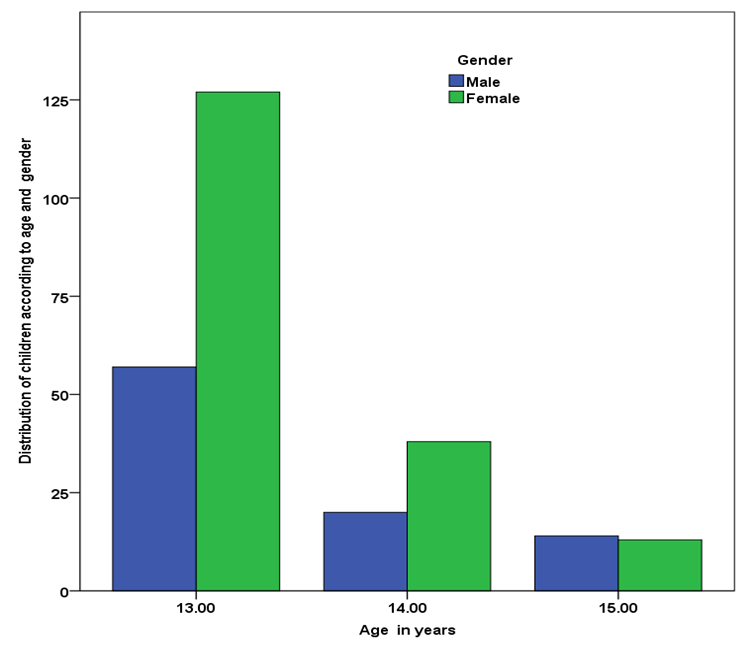 | Figure 1. Distribution of the Respondents by age and gender |
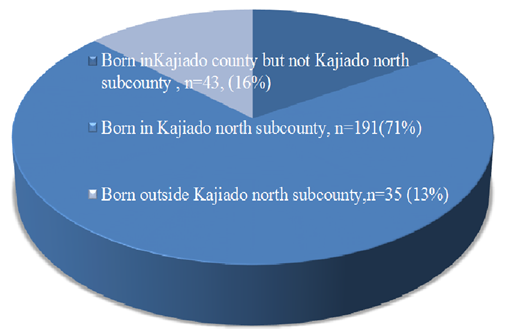 | Figure 2. Place of birth |
|
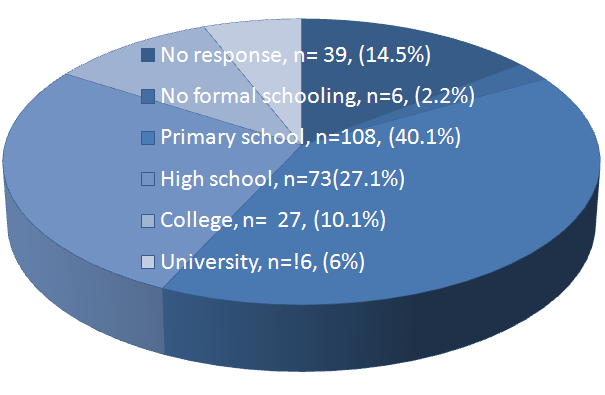 | Figure 3. Caregivers level of education |
|
 | Figure 4. The distribution of the Intellectual efficiency score for the adolescents |
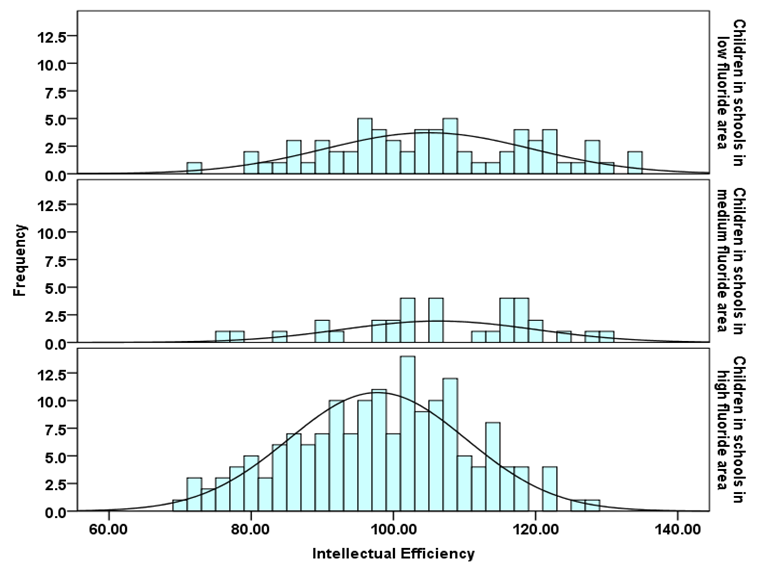 | Figure 5. Distribution of the children according to the intellectual efficiency sores and location of the school |
 | Figure 6. Difference in the mean intellectual efficiency according to fluoride area |
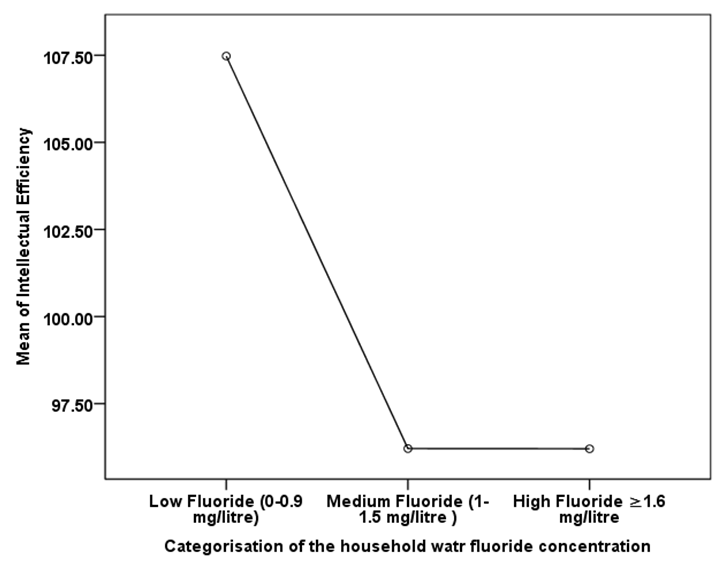 | Figure 7. Categorisation of fluoride concentration in household water and the intellectual efficiency of the children |
 | Figure 8. The mean intellectual efficiency and the fluoride concentrations in the household water |
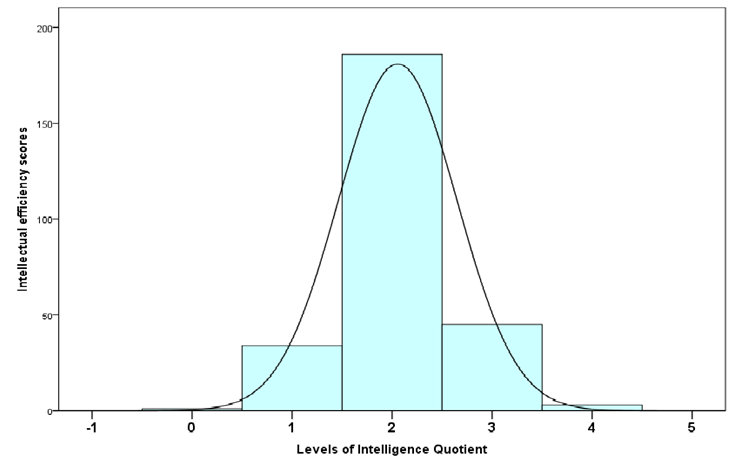 | Figure 9. Levels of intellectual Efficiency |
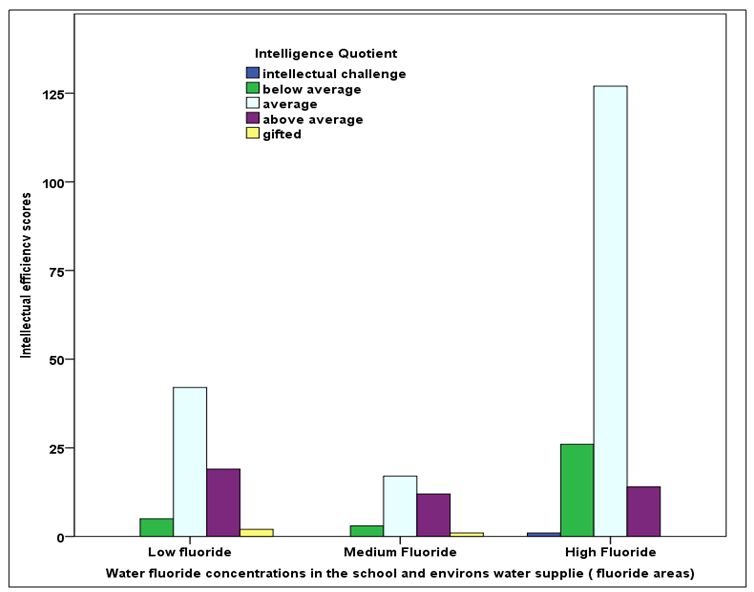 | Figure 10. The fluoride concentration in the school and environs water supply in relation to the intellectual efficiency levels |
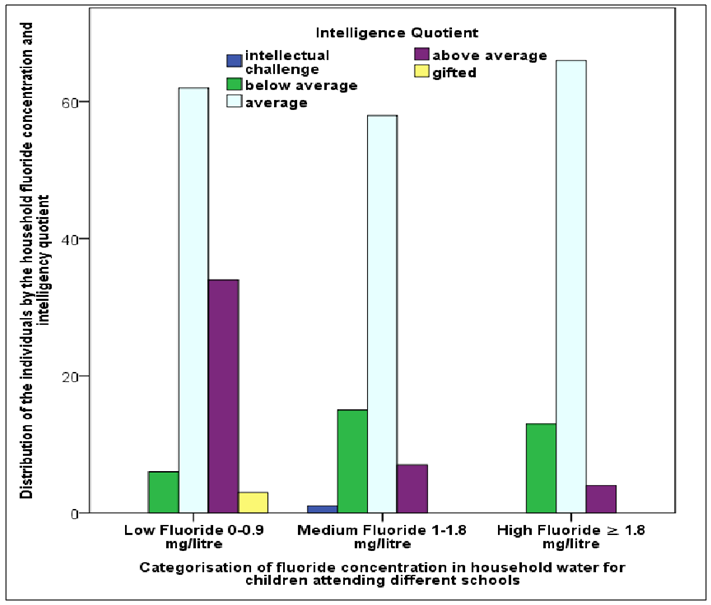 | Figure 11. Categorisation of fluoride concentration in household water and the intelligent efficiency levels |
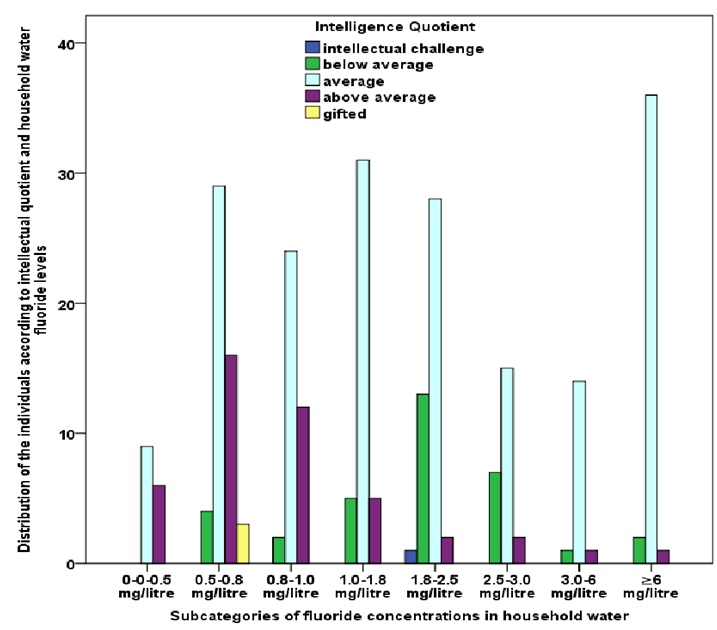 | Figure 12. Intellectual efficiency levels and fluoride in household water categorisation |
4. Discussion
- Intellectual efficiency is one of the scales intended to assess the individuals’ social interaction [22]. Those who score high in IE are considered to have the superior intellectual ability, to be self-reliant, independent, dominant and strong. Those who score low are lacking in self-direction, self-discipline, confused, cautious and unambitious [22]. Intelligence is the native aptitude for acquisition while intellectuality represents the amount acquired [23]. The two are correlated. When fluoride is taken in low concentrations, it helps in the development of the human [24, 25]. But in excess, it has both visible and invisible effects [26]. Kenya’s Rift Valley is documented to have one of the highest water fluoride concentration recorded world wide [27]. Kajiado County, Kajiado North sub-county falls in the Great Rift Valley of Kenya. Therefore, it formed a suitable site for the study. The majority, two hundred and forty-two (90%), of those interviewed and who took part in the study were between 13 and 14 years old. In Kenya, this is the school going age at which most children are just completing or about to end their primary school education.In this study more, females participated than the males. In recent years more emphasis has been placed on the girl child using selective interventions and programmes in the subcounty which may push the boy child to develop lower esteem and loose confidence [28]. The impact of targeted interventions and programmes was evident in this study where the boy child showed minimal interest or was too shy and timid to participate. The study shows that fluoride exposure is associated with reduced intellectual ability in the adolescents. There is a significant inverse relationship between water fluoride levels in both area and household and intellectual efficiency. The degree of exposure in the current study was checked by analysis of the household water fluoride. Several studies have reported the effects of fluoride on intelligence. Despite some confounders, most of the studies have suggested fluoride has a negative impact on intelligence hence intellect [29-32]. The differences in the IE between the low, medium, and high fluoride concentrations was significant with ANOVA p≤.001. The children whose water fluoride had the lowest level was between 0-1.0 mg/litre had the highest mean IE score of 107.47±13.03 followed by eighty-one (30.1%) individuals whose water had medium fluoride content which ranged between 1.1 -1.8mg/ litre whose average IE was 96.20 ±12.39. However, eighty-three (30.9%) children whose household water had the highest fluoride in the water had the lowest mean IE of 96.20 ±12.06. The differences in IE was significant between IE for the children whose water had low and medium then low and high with p≤.001. However, no differences were observed between the mean IE (96.20 ±12.39) of eighty one (30.1%) children who used water with a fluoride content of medium 1.1-1.8 mg/l and eighty three (30.9%) whose mean IE was 96.20 ±1 the 2.06 and had used household water with a higher than 1.8 mg/litre with p=1 at 95% CL. Arsenic and lead have also been shown to cause a decline in intellectual function [29, 32]. In the present study heavy metal presence in the water was not detected, and therefore any deficits in the individual's intellectual efficiency would not be attributed to the effect of this heavy metals. Tang concluded that children in endemic fluoride areas were at higher odds about five more times likely to develop low IQ in comparison to those who resided in areas without fluoride [30, 33]. Fluoride penetrates the placenta and the blood-brain barrier [14, 30, 33, 34]. When subsequently there is continuous exposure to fluoride it negatively affects the CNS during development thus lowering the intellect and intelligence [14, 30, 33, 34]. Although there is lowered intelligence, the mechanism by which this happens is not yet clearly understood. From the evidence in human and animal studies, it has been postulated that there may be an alteration in the membrane lipid leading to reduced cholinesterase activity in the brain. The reduced cholinesterase activity in the brain may change how impulses in the brain are transmitted [26, 35, 36]. Chirumari et al. found that the dopamine, 5-hydroxyindoleacetic) acid, epinephrine, serotonin, homovanille acid and norepinephrine were altered by NaF in the neocortex and hippocampus of the brain of a rat. In endemic fluorosis areas, there are changes in the receptors and the neurotransmitters in the brain of the foetus [37]. Shuseela found that excess fluoride intake leads to impaired function of the thyroid hence causing iodine deficiency [38].
5. Conclusions
- Children exposed to fluoride risk developing impaired intellectual efficiency which also affects the IQ. With the Rift Valley being a high fluoride area, there is a risk. The high number of children with below average IE means that in class they do not have a fair chance of learning and there may be a need for the children to be assessed so that they are enabled to build the learning milestones a catch up with the above average. The Kenyan education system also emphasises rote learning with a syllabus which has minimal creative knowledge such as music and art hence children of below average and those who are mentally challenged may find it difficult in excelling.
Limitations
- Inheritance influences intellect. Only the fluoride content in water was analysed as the marker for exposure to fluoride, and therefore this does not account for other sources of fluoride to the body. Urine would have been a better measure of all sources of fluoride to the body [39]. Nutritional status was also not considered, and this has been shown to affect intelligence [40, 41]. Although children who had changed their water source since birth were excluded, recall bias is still possible and fluoride in water changes according to seasons. The difference in household water fluoride may be an indicator of parental and society knowledge on effects of fluoride, and therefore an attempt is made to get fluoride free Water source for domestic use.
ACKNOWLEDGEMENTS
- The chairman, the dean of the department of paediatric dentistry, School of Dental Sciences, College of Health Sciences, the University of Nairobi for facilitating. The faculty and peers in the department of paediatric dentistry, School of Dental Sciences, for constructive criticism which improved the study. The children and the parents who accepted to participate in the study. The headmistress and the teachers who allowed us to run the study in their schools and for organising the children. The relevant bodies which read and approve the research proposal at the university, county and National level.
 Abstract
Abstract Reference
Reference Full-Text PDF
Full-Text PDF Full-text HTML
Full-text HTML